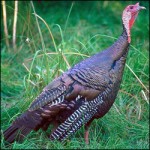All Eyes On The Turkey!
No, keep your eyes off that bottle of Wild Turkey, we are talking about the one on the table. After multiple trips to the eye doctor it has been concluded that the turkey sees better than you do. Fortunately (for most of us anyway) it is not quite as bequeathed with intelligence. Then again, that turkey scored higher on its eye exam.
Like all birds, turkeys have specialized anatomy to help them thrive in the air. Avian vision is truly remarkable. Turkeys can literally turn thier head backwards (actually almost a full rotation exorcist style) and see behind them. Remember your 3rd grade teacher who everyone was sure could do just that? Daytime vision is extremely good in wild turkeys, exceeding our 20/20 ideal. Turkeys can actually see ultraviolet light in the UVA range. In addition to utilizing color vision as an aid in mating, they may also see UV secretions that are spread across their feathers to identify potential mates. Maybe black light techno dances are connected somehow?
The Third Eye- The Reason For Trifocals
Turkeys have a nictitating membrane or a third eyelid. That is not to be confused with a nicotine membrane that used to develop right outside your third grade teachers lounge. The nictitating membrane is covered with goblet cells. (Those are not quite the same as gobbler cells). People are inferior to turkeys and stuck with a little remnant of tissue referred to as the plica semilunaris. (Of course, the turkey is the one sitting on a platter). The nictitating membrane is transparent in birds allowing visualization of the environment. It functions to prevent dry eyes while in flight and offers some level of protection. (That can be very important to turkeys who hang their head out the window while driving 70 mph). The nictitating membrane is part of the mucosal defense system of the eye. In my experience personally and as an optometrist, any form of mucosal defense works quite well in a crowded environment. If you have any further questions about mucosal defense ask a preschooler. They are all black belts in mucosal defense.
Eye Brighteners, Dirty Clothes, And Pumpkin Colored Contact Lenses
If you do not have your turkey dinner lined up yet take note of the super sharp eyesight and better than 20/20 vision common in the turkey community. If you like your clothes clean and use laundry whiteners you may go hungry. Brighteners absorb UV radiation and emit blue light in its place. Turkeys are pretty good at visually picking up on blue light specials, especially at this time of year. (Imagine what kind of sight greets their eyes if you have been using teeth whiteners). If you are going turkey hunting, you might want to consider having someone switch out the gobblers current contact lenses for one of the UV blocking contact lens brands.
Substitute Pumpkin Colored Contact Lenses And You Will Be More Likely To Discover Your Inner Turkey This Year
No avatar movies for turkeys since thier eyes are placed pretty far laterally on thier heads. What they lack in binocular 3D vision is compensated for with monocular vision clues produced by good old head bobbing and wagging. (Kind of like that 3rd grade teacher that never missed anything).
On a final note, it is the holiday season and you can never be too careful so keep a sharp eye out for idiopathic postprandial syndrome. According to the experts at Wikipedia, idiopathic postprandial syndrome is a syndrome that occurs 2-4 hours after finishing a meal, whose cause is completely unknown and not understood. So if you eat and feel funny a couple of hours later, well good luck with that!

Comments 2
Pingback: 5 Fun Facts About Turkeys — Yes, They Can Fly (and Change Color) | Voice of Amarillo 940
Author
Gobble Gobble!